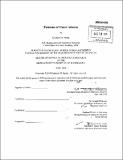Patterns of heart attacks
Author(s)
Shenk, Kimberly N
DownloadFull printable version (11.72Mb)
Other Contributors
Massachusetts Institute of Technology. Operations Research Center.
Advisor
Natasha Markuzon and Dimitris J. Bertsimas.
Terms of use
Metadata
Show full item recordAbstract
Myocardial infarction is a derivative of heart disease that is a growing concern in the United States today. With heart disease becoming increasingly predominant, it is important to not only take steps toward preventing myocardial infarction, but also towards predicting future myocardial infarctions. If we can predict that the dynamic pattern of an individual's diagnostic history matches a pattern already identified as high-risk for myocardial infarction, more rigorous preventative measures can be taken to alter that individual's trajectory of health so that it leads to a better outcome. In this paper we utilize classification and clustering data mining methods concurrently to determine whether a patient is at risk for a future myocardial infarction. Specifically, we apply the algorithms to medical claims data from more than 47,000 members over five years to: 1) find different groups of members that have interesting temporal diagnostic patterns leading to myocardial infarction and 2) provide out-of-sample predictions of myocardial infarction for these groups. Using clustering methods in conjunction with classification algorithms yields improved predictions of myocardial infarction over using classification alone. In addition to improved prediction accuracy, we found that the clustering methods also effectively split the members into groups with different and meaningful temporal diagnostic patterns leading up to myocardial infarction. The patterns found can be a useful profile reference for identifying patients at high-risk for myocardial infarction in the future.
Description
Thesis (S.M.)--Massachusetts Institute of Technology, Sloan School of Management, Operations Research Center, 2010. Cataloged from PDF version of thesis. Includes bibliographical references (p. 66-68).
Date issued
2010Department
Massachusetts Institute of Technology. Operations Research Center; Sloan School of ManagementPublisher
Massachusetts Institute of Technology
Keywords
Operations Research Center.